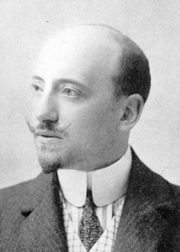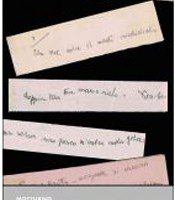Gabriele D’Annunzio wrote Notturno on strips of paper big enough for just one line a piece, while his eyes were bandaged into near blindness, as he convalesced for over two months from an eye injury. As Virginia Jewiss writes in the preface, “…Notturno offers one of the most extraordinary stories of literary creation ever conceived.” I prefer to first experience a work in a kind of vacuum, with as little knowledge of the author’s life and context of composition as possible. For the first reading, I’m looking for a pure relationship with the words themselves, hoping to have thoughts and reactions that belong to me alone. Other context comes later, to complicate or deepen my initial interpretations. But Notturno‘s method of composition is central to the experience of reading it.
D’Annunzio opens with a description of his technique; the sound of paper being cut into strips, the arrangement of his body on the hospital bed, the angle of the writing board, the position of his fingers, the motion of his hands precisely controlled so “none of their shaking is transmitted to [his] bandaged head.” (p. 3) He discusses the progress of his recovery, describes his pain (“Tonight the demon takes my glowing eye in the palm of his hand and blows on it with all the might of his swollen cheeks.”) and relates his treatment. He even closes the poem with a recapitulation of the opening image, a demonstration for a visiting friend who noticed the “sibylline sheets scattered across the bed.” Somewhat like the Dadaist aleatory composition that preceded and Oulipo’s formalism that followed, the method of composition is part of the fabric of the work. The blindfolded D’Annunzio wrote a stunningly visual, 288 page prose poem, one strip of paper at a time.
Reading Notturno is like following some inherent turbulence from painting to painting in an art gallery. “The motorman is from Siracusa. We talk about the sun, the heat, the oranges, the almond trees in bloom, Taormina; I see the Latomie again, the theater, the Venus, the Ram…” (p. 25) “Touch the bottom of my wound with melody, and there awaken ineffable colors that exist only in the light-spectrum of stars.” (p. 119) “The fire is like a tattered flag, hoisted up a mast.” (p. 183) “I dreamt I was folding my flesh like a colorless cape./ Then I dreamt I unfolded it and hung it from a nail jutting out from a colorless wall.” (p. 208) Notturno is composed not just of lines and paragraphs but of verbal portraits and landscapes.
In the Post Scriptum, D’Annunzio writes, “The optic nerve drew from every layer of my culture and prior life, projecting countless images into my field of vision with a swiftness of transition unknown even in my boldest flights of lyricism.” (p. 290) When one is blind, other senses intensify to compensate. With D’Annunzio, instead of another sense compensating for his temporary lack of sight, the language of sight intensified. In essence, “Hallucination takes the shape of a reality so vivid that present, speaking people are, by comparison, bodiless phantoms.” (p. 227) Through his linguistic sensory compensation, D’Annunzio captures one of the powers of literature; creating an experience with a depth of substance greater than reality.
To describe Notturno as a substantive work is a dramatic understatement. Death, war, the Aristotelian elements, Catholicism, Futurism, and Fascism. The body in pain. A Song of Myself of cracks and seams. An In Search of Lost Time for WWI pilots and Venice. Martyrdom and valor. The sanctification of soldiers. The transitions of technology. The bravado of the poet. The power of the image. Translator Stephen Sartarelli says this, “His is a poetics of accumulation and contradiction sustained…by his stylistic mastery holding it together.” (p. xiii) Notturno is a scholar’s/critic’s/reader’s mine, an endless vein of interpretation; a bounty that poses a strange challenge to the reviewer. How do you demonstrate the expanse of the work in a little over a thousand words? One does not review Notturno, one writes a thesis on Notturno.
However, contemporary readers will be puzzled, if not downright disgusted, by D’Annunzio’s military chauvinism. When considered alongside his contemporary English language war poets, his ebullience for war and his fetishizing of death in war is baffling. Veterans usually aren’t so damn jazzed about fighting. One of the closing images is of a peasant who slowly drowns himself to avoid revealing the location of a ford in the river to the enemy. To me, this is a very complicated image, but to D’Annunzio, it contains some of the simplest and most direct lines in the poem. To him, dying for the fatherland is the best of all possible deaths. It is “an even better way to die.”
 But even as he glorifies war, he does not sanitize it. “He sets the grim package down on the counter the way a merchant lays down a bolt of fabric to be measured by the yard./ These are the remains of Alfredo Barbieri from the Ljubljana mission.” (p. 66) “One barrage of fire had massacred our men./ The bloody pile was far away but seemed to be approaching with a slithering of entrails.” (p.256) He was wounded. His friends and comrades killed. He mourned the fallen with a passion approaching mania. But not only did he glorify war in writing, he begged to fight, and used his fame and influence to secure permission to fly on bombing missions even after his afflicted eye was amputated.
But even as he glorifies war, he does not sanitize it. “He sets the grim package down on the counter the way a merchant lays down a bolt of fabric to be measured by the yard./ These are the remains of Alfredo Barbieri from the Ljubljana mission.” (p. 66) “One barrage of fire had massacred our men./ The bloody pile was far away but seemed to be approaching with a slithering of entrails.” (p.256) He was wounded. His friends and comrades killed. He mourned the fallen with a passion approaching mania. But not only did he glorify war in writing, he begged to fight, and used his fame and influence to secure permission to fly on bombing missions even after his afflicted eye was amputated.
Given this romantic chauvinism and commitment to fascism, it’s clear why D’Annunzio hasn’t been read much in English, despite his prominence and importance in 20th century Italian literature. For some reason, it has been easier for contemporary readers to forgive these flaws in the Futurists than in D’Annunzio, perhaps because of how they fit into the broader trajectory of avant garde literature. But Notturno cannot be reduced to this one flawed theme. It has too much depth to be cast aside with the rest of fascist literature. As D’Annunzio himself says, “I write like one casting an anchor: the hawser pays out faster and faster, the sea appears bottomless, and the fluke never manages to catch, nor the hawser to tauten.” (p. 14) Or, to return to the idea of sensory compensation, D’Annunzio is writing to enact experience, to engender things from words, to make the hallucinations real. As much as a writer can succeed in this, D’Annunzio succeeds. He gets close to the power he describes here, “I like the name so much that I need only say [zagara] to smell the fragrance.” (p. 82)
My notes for this review include several pages of quotes, lines I was compelled to record because my duty as a reviewer is to transmit, as much as possible, a representation of the beauty I find in the book, and because transcribing is my way, as a reader, to honor the author’s triumphs. To D’Annunzio’s mindset, highlightings, underlinings, and transcribings are medals readers pin to the writer’s chest; the proof of valor, the record of triumph, the substance of honor. Following that image, Notturno is like a vastly decorated general; intimidating, ambitious, intelligent, and, in all connotations and denotations of the word, excellent.





4 responses
I am Italian, I am a writer and I studied D’Annunzio in Italy for years and years and years. I have never read anything this beautiful about one of my favorite Italian poets. You nailed it. Bravo.
Thank you so much Alice. I don’t read the comments to my reviews very often, so that’s why I’m responding two months later. I really appreciate you taking the time to leave your thoughts and praise. Josh
An excellent review. So well done. One hears lots of talk of neglected authors and masterpieces, but Notturno is the real thing. D’Annunzio was a mixed bag, for sure; despicable in his politics and distasteful in other respects. This was, after all, the man who had the front end of a battleship carted to his landlocked villa as a monument to the glories of war but mainly to his own vainglory. But he was also an exquisite writer, and Notturno is his masterpiece. Odds of one having read anything like it are slim indeed.
“Given this romantic chauvinism and commitment to fascism, it’s clear why D’Annunzio hasn’t been read much in English, despite his prominence and importance in 20th century Italian literature.”
It’s important to note that D’Annunzio predates Fascism and Futurism; both were modeled after his classical beliefs and rhetoric, both eventually becoming distorted from their original source. This is a man who called the Germans and English “barbarians.” Pound’s Cantos could not have existed without D’annunzio.
Click here to subscribe today and leave your comment.